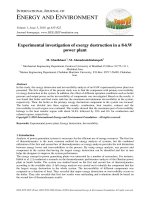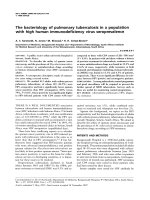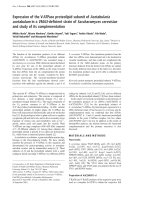Post fire dynamics of Cistus spp. in a Pinus brutia forest
Bạn đang xem bản rút gọn của tài liệu. Xem và tải ngay bản đầy đủ của tài liệu tại đây (56.13 KB, 7 trang )
Turk J Bot
29 (2005) 337-343
â TĩBTAK
Research Article
Post-Fire Dynamics of Cistus spp. in a Pinus brutia Forest*
ầaÔatay TAVfiANOLU**, Behzat GĩRKAN
Ecology Section, Department of Biology, Hacettepe University, 06532 Beytepe Ankara - TURKEY
Received: 15.10.2004
Accepted: 06.06.2005
Abstract: The population dynamics of 2 species of Cistus L. (C. salviifolius L. and C. creticus L.) were studied along a post-fire
successional gradient in Pinus brutia Ten. forests in Marmaris National Park, Turkey. The population density of Cistus spp. was 16
-2
2
individual m at the end of the first year after fire and then decreased exponentially (r = 0.926, P < 0.001) the second year after
fire to later successional stages. Total projected foliage cover of Cistus spp. was 26% by the end of the first year after fire, it
increased to approximately 38% during the second year after fire and decreased linearly (r2 = 0.872, P < 0.01) beyond this time.
Rates of establishment of Cistus spp. were high in the first year after fire but were low in subsequent years and most of the Cistus
plants flowered during the second year after fire. There was a significant positive relationship between the density of new seedlings
2
of Cistus and cover of Pinus brutia trees in the sixth year after fire (r = 0.242, P = 0.002). Seed yield of Cistus was reduced due
to predation of seed capsules by Bruchid insects. Both species of Cistus were shown to be typical post-fire colonisers in terms of
timing of recruitment and post-fire population dynamics. The major factors responsible for the decrease in density of seedlings of
C. salviifolius and C. creticus are likely to be the mortality of young seedlings due to summer drought and competition among
seedlings and with P. brutia trees. It is suggested here that the species considered have fire-dependent establishment behaviour and
an increase in population is restricted to early post-disturbance in P. brutia forests in Turkey, as in other Mediterranean regions.
Key Words: Post-fire colonisers, post-fire succession, Cistus creticus, Cistus salviifolius, Turkey
Bir Pinus brutia Ormannda Yangn Sonras Cistus spp. Dinamikleri
ệzet: Cistus salviifolius L. ve C. creticus L.un populasyon dinamikleri, Marmaris Milli Parknda Pinus brutia Ten. ormanlarnda bir
yangn sonras sỹksesyonal gradiyent boyunca arafltrlmfltr. Cistus spp. populasyon yoÔunluÔu yangndan sonra birinci yln sonunda
-2
2
16 birey m iken, yangn sonras ikinci yldan ileri sỹksesyonal evrelere kadar ỹssel olarak azalmfltr (r = 0,926, P < 0,001). Yangn
sonras birinci yln sonunda Cistus spp.un ửrtme derecesi %26 iken, yangn sonras ikinci ylda yaklaflk %38e kadar artmfl ve daha
sonra doÔrusal olarak azalmfltr (r2 = 0,872, P < 0,01). Cistus spp.un alana yerleflme orannn yangn sonras ilk ylda yỹksek, takip
eden yllarda ise dỹflỹk olduÔu gửrỹlmỹfltỹr. Yangn sonras ikinci ylda birỗok Cistus bitkisi ỗiỗeklenmifltir. Yangn sonras altnc ylda,
yeni ortaya ỗkan Cistus fidelerinin yoÔunluÔu ile Pinus brutia aÔaỗlarnn ửrtme derecesi arasnda ửnemli bir pozitif iliflki gửzlenmifltir
2
(r = 0,242, P = 0,002). Cistus spp.un tohumlarnn bir ksmnn tohum kapsỹllerinden beslenen Bruchid bửcekler tarafndan
predasyona uÔradÔ saptanmfltr. Her iki Cistus tỹrỹ de alana yerleflme zamanlar ve yangn sonras populasyon dinamiklerine gửre
kolonici tỹr ửzelliÔi gửstermektedirler. C. salviifolius ve C. creticus fidelerinin yoÔunluÔunun azalmasnda rol oynayan en ửnemli
etmenler arasnda genỗ fidelerin yaz kuraklÔndan kaynaklanan mortalitesi ile diÔer fideler ve P. brutia aÔaỗlaryla aralarndaki
rekabet saylabilir. Arafltrlan tỹrlerin, diÔer Akdeniz civar ỹlkelerde olduÔu gibi, Tỹrkiyedeki P. brutia ormanlarnda da yangna
baÔml yerleflme davranflna sahip olduklar ve populasyonlarndaki artfln mỹdahale sonras erken dửnemle kstl olduÔu sonucuna
varlmfltr.
Anahtar Sửzcỹkler: Yangn sonras koloniciler, yangn sonras sỹksesyon, Cistus creticus, Cistus salviifolius, Tỹrkiye
Introduction
Species of Cistus L. are considered the most common
post-fire colonisers in the Mediterranean Basin (Troumbis
& Trabaud, 1986; Moravec, 1990; Thanos, 1999). Even
if they are absent in mature forests, they generally persist
in soil seed banks and may reappear in these areas after
a fire (Troumbis & Trabaud, 1986; Thanos et al., 1992;
Thanos, 1999). The opportunistic nature of Cistus
species is reflected in their reproductive characteristics
(Thanos & Georghiou, 1988). For example, seeds of most
* This study was part of the requirement for the MSc degree submitted to Hacettepe University on 25.02.2002.
** Corresponding author: E-mail:
337
Post-Fire Dynamics of Cistus spp. in a Pinus brutia Forest
species of Cistus spp. have hard coats (Thanos &
Georghiou, 1988; Thanos et al., 1992) which inhibit
uptake of water from the environment (Corral et al.,
1990), allowing seeds to remain dormant for long
periods of time (Trabaud et al., 1997; Thanos, 1999).
Seed dormancy can be broken by high temperatures such
as those produced during fire (Trabaud & Oustric, 1989;
Pugnaire & Lozano, 1997) or mechanically by other
disturbances such as tilling or ploughing the soil
(Troumbis & Trabaud, 1986). In recently burnt areas in
the Mediterranean Basin, species of Cistus germinate in
massive numbers and reach high seedling densities in a
short period of time (Arianoutsou-Faraggitaki &
Margaris, 1982; Thanos & Georghiou, 1988; Thanos et
al., 1989; Skourou & Arianoutsou, 1998; Eshel et al.,
2000).
Forests of Pinus brutia Ten. occupy large areas in the
east Mediterranean Basin (Davis, 1965-1985; Panetsos,
1975). Species of Cistus are often associated with P.
brutia as an understorey layer in the Aegean region of
Turkey and East Aegean Islands (Carlström, 1987;
Thanos & Marcou, 1991; Spanos et al., 2000). Although
light intensity under the mature canopy of P. brutia is low
(Neyiflçi, 1987), germination of species of Cistus is not
affected by light availability (Thanos & Georghiou, 1988;
Thanos et al., 1992; Keeley & Baer-Keeley, 1999;
Trabaud & Renard, 1999). Despite this, seedling
establishment does not generally occur in mature Pinus
forests (Skourou & Arianoutsou, 1998; Trabaud &
Renard, 1999; Eshel et al., 2000). Consequently, in
burnt Pinus forests, populations of Cistus increase in size
in the first few years after fire (Peflmen and Oflas, 1971;
Thanos et al., 1989), and generally decrease gradually
with time (Schiller et al., 1997). Early on, seedling death
is likely to be due to competition for resources (Ne’eman
et al., 1995; Vilà & Sardans, 1999), and later as a
consequence of the short life span of these shrubs
(Arianoutsou-Faraggitaki & Margaris, 1982; De las Heras
et al., 2002).
Although this general process is well known, the
population dynamics of species of Cistus have not
previously been studied in Turkey. The aim of the present
study was to determine the post-fire dynamics of 2
species of Cistus (C. salviifolius L. and C. creticus L.) along
a post-fire successional gradient in P. brutia forests in
Marmaris National Park, Turkey. This study will
contribute to the current literature on this subject.
338
Methods
Study site
The study area was located in Marmaris National Park
in south-western Turkey. The climate is typically
Mediterranean with frequent drought during summer
and cool, wet winters. Using Emberger’s method
(Akman, 1999; Dufour-Dror and Ertas, 2004), a climatic
classification type based on photoperiodism, temperature
and precipitation regimes, and the long-term climatic data
of the study area (1961-2000, Turkish State
Meteorological Service), a bioclimatic analysis was
conducted. Of the bioclimatic parameters, maximum
mean temperature of the hottest month (M) is 45.2 ºC,
minimum mean temperature of the coldest month (m) is
-3.5 ºC, mean yearly precipitation (P) is 1233 mm, and
the pluvio-thermic quotient (Q) is 86.1. The quotient Q is
an estimate of M, m and P, and gives the bioclimatic type
of the study area with m. After the values for Q and m
are calculated and placed in the Emberger’s “climagram”
(Akman, 1999; Dufour-Dror and Ertas, 2004), they
indicate that the National Park area has a ‘sub-humid
Mediterranean climate with very cold winters’.
Three sites that had been burnt in different years
(1999, 1995 and 1979) and a fourth site, which had not
been burnt for at least 45 years, were selected for the
study. The sites were located very close to each other
(site burnt in 1999: 36º50’11’’N, 28º18’10’’E; site burnt
in 1995: 36º51’16’’N, 28º17’14’’E; site burnt in 1979:
36º49’37’’N, 28º19’34’’E; long unburnt site:
36º50’47’’N, 28º17’24’’E) and each was at least 1 ha in
size. Dominant plant species included Pinus brutia, C.
salviifolius, C. creticus, Quercus infectoria Olivier,
Phillyrea latifolia L. and Smilax aspera L. Nomenclature of
the plant species follows Davis (1965-1985).
Estimation of cover and density
Forty 1 x 1 m plots were established randomly in each
of the 4 sites. Individuals of Cistus salviifolius and C.
creticus were counted and percentage projected foliage
cover determined in each plot. As C. salviifolius and C.
creticus share similar post-fire regeneration strategies
and they are both typical post-fire pioneer species,
germination and cover were evaluated together to give a
generic rather than a specific response.
Assessment of populations of sites burnt in 1999 and
1995 were conducted in September 2000 and September
2001, and assessments of the site burnt in 1979 were
Ç. TAVfiANO⁄LU, B. GÜRKAN
carried out in September 2000 and July 2001. The long
unburnt site was assessed in September 2000. According
to the synchronic approach, these sampling times were
equivalent to 1 and 2 (for the site burnt in 1999), 5 and
6 (for the site burnt in 1995), 21 and 22 (for the site
burnt in 1979), and 45 (for the long unburnt site) years
after fire. Additional monthly assessments were
conducted from March 2001 to September 2001 to
determine whether any new seedlings had emerged. Total
projected foliage cover of seedlings of both species of
Cistus and mature trees of Pinus brutia were assessed in
each plot. Seed capsules of Cistus were collected from
randomly selected individuals in each site in September
2001 to determine whether they were infested by seed
parasites.
Statistical analysis
Regression analysis was used to test for significant
changes in the density and cover of the 2 species of Cistus
with time after fire. The statistical significance of
regression curves was tested with t-statistics (Fowler &
Cohen, 1990) after transformation of curves to linear
lines by log-transformation of ordinate data or, if needed,
both ordinate data and axis data. Regression curves were
drawn only if they were statistically significant.
Spearman’s rank correlation coefficient (rs, Sokal &
Rohlf, 1981) was used to test if there was any significant
relationship between cover of P. brutia and emergence of
seedlings of Cistus.
Results
C . salviifolius were always found in greater
densities and with greater foliage cover than C.
creticus at all sites and sampling times. When both
species were considered together, the population
density of Cistus spp. was approximately 16
individuals m-2 within 1 year of fire and density
decreased exponentially (P < 0.001) from the second
year after fire to later successional stages (Figure 1).
The exponential decrease in density was due to the death
of individuals of C. salviifolius rather than of C. creticus.
Although the regression curve was not statistically
significant in the latter species (y = 3.26x-0.7063, r2 =
0.619, d. f. = 4, P > 0.05), there was also a considerable
decline in population density with time. The long unburnt
site had very low densities of Cistus (0.21 individuals
m-2) throughout the study period.
Total cover of Cistus spp. was 26.0% by the end of
the first year after fire and had increased to 37.6% by
the second year. Total cover decreased linearly beyond
the second year after fire (Figure 2, P < 0.01), and in the
long unburnt plots the total combined cover of Cistus was
only 4.3%.
It was observed that most of the individuals of Cistus
(especially C. creticus) had flowered and produced seed
(that is, reached maturity) in the second after-fire year. It
was also observed that the major factor responsible for
20
density (individuals/m2)
18
16
Cistus total,
y = 9.5447e-0.0798x
r2 = 0.9263, d.f. = 5, P < 0.001
14
12
10
C. salviifolius,
y = 6.8344e-0.0743x
r2 = 0.9456, d.f. = 5, P < 0.001
8
6
4
2
0
0
5
10
15
20
25
30
post-fire years
35
40
45
50
Figure 1. Post-fire decrease in the total density of Cistus spp., C. salviifolius and C. creticus.
Circles and the upper regression curve represent the total densities of Cistus, triangles
and the lower curve represent the densities of C. salviifolius, and black squares
represent the densities of C. creticus. The values are means and the error bars
represent ± SE.
339
Post-Fire Dynamics of Cistus spp. in a Pinus brutia Forest
coverage (%)
45
40
35
30
25
20
15
10
y = -0.6379x + 35.665
r2 = 0.8718, d.f. = 4, P < 0.01
5
0
0
5
10
15
20
25
30
post-fire years
35
40
45
50
Figure 2. Post-fire (from second year after fire) decrease in the total cover of Cistus spp. (C.
salviifolius and C. creticus). Note that the square is the cover value of the first year
after fire and the circles are the cover values of successive years after fire. The values
are means and the error bars represent ± SE.
loss of Cistus seed yield was infestation of seed capsules
by Bruchid insects (34.5% of capsules C. creticus, n =
226, and 28.1% of C. salviifolius capsules, n = 892) in all
study sites.
New seedlings of Cistus emerged only during May
2001 at the site burnt in 1999 and for a more extended
period (June, July, August and September 2001) at the
site burnt in 1995. No new Cistus seedlings emerged at
the site burnt in 1979 or at the long unburnt site during
the study period. Newly emerged seedlings of Cistus
appeared in late spring at the site burnt in 1999;
however, they did not become established and had
disappeared by the time of the next monthly assessment.
Seedlings that had emerged during spring at the site
burnt in 1995 remained alive until early summer, and
additional seedlings could be counted until September
(Table 1). It was observed that the spatial distribution of
these new Cistus seedlings was restricted to locations
beneath Pinus saplings in the site burnt in 1995. Indeed,
there was a significant relationship between Cistus
seedling number and Pinus sapling cover values in study
plots in this site (rs = 0.242, P = 0.002, n = 160).
Discussion
The density and cover of Cistus reached very high
values in a short period of time after fire and this can be
attributed to increased rates of germination immediately
after disturbance (Troumbis & Trabaud, 1986; Thanos &
Georghiou, 1988; Trabaud & Oustric, 1989; Thanos,
340
Table 1. Mean densities of newly emerged seedlings of Cistus spp.
(mean individuals m-2 ± SE) as measured monthly in 2001
at the study sites burnt in 1999 and 1995.
March-April
site 1999
site 1995
0
0
May
1.5 ± 1.1
0
June
0
0.9 ± 0.8
July
0
1.1 ± 0.6
August
0
1.3 ± 1.0
September
0
1.2 ± 0.8
1999). The population density showed a marked
decrease in the second year after fire, while cover values
continued to increase. The increasing cover values were
likely to be due to the rapid growth and development of
Cistus seedlings after fire.
The decrease in the population density of Cistus spp.
slowed with successional time and the overall trend
followed an exponential curve. Such a pattern is similar to
that found by Schiller et al. (1997) for Cistus growing in
Pinus halepensis Mill. forests. The summer drought and
intense competition for resources may be responsible for
the abrupt decline in the population density of Cistus spp.,
especially in the early and mid-successional stages (Vilà &
Sardans, 1999).
As a result of such decreases, Cistus had very low
densities in the long unburnt site, although later deaths
Ç. TAVfiANO⁄LU, B. GÜRKAN
may be attributed to the biological properties of Cistus
rather than to the effects of competition. In the absence
of competition, a decline in the population is to be
expected as they are short-lived species (De las Heras et
al., 2002). In a mature P. brutia forest in which seedling
establishment does not readily occur if there is no
disturbance, species of Cistus apparently disappear locally
with time (Trabaud & Renard, 1999). The general trend
in decreasing population density of Cistus spp. with
successional time fits a recent simulation model predicting
decreases in Cistus populations with increasing fire-free
period (Pausas, 1999).
Most of the individuals of both species of Cistus
flowered and reached maturity in the second year after
fire. Although there have been accounts of flowering
being delayed until 3 years after fire (Ferrandis et al.,
1999; Trabaud & Renard, 1999; Eshel et al., 2000;
Ferrandis et al., 2001), the early flowering of C.
salviifolius (Thanos et al., 1989; Ferrandis et al., 1999)
and C. creticus (Thanos et al., 1989) has also been
documented. This short juvenile period may be an
adaptation against the possibility of a repeated fire.
Pausas & Vallejo (1999) suggested that if the timing of
the recurrence of fire is shorter than the age of maturity,
the species would be locally eliminated. Species of Cistus
guarantee maintenance of their population within a very
short period by producing seeds in their second or third
years and having them accumulate in the soil seed bank.
The seed yield of both species of Cistus was reduced
by predation by the seed beetle Bruchidius biguttatus
Olivier (Coleoptera: Bruchidae) at all study sites.
However, since large numbers of seeds are produced
every year and these seeds accumulate and can remain
viable in the soil seed bank, this loss may not impact on
the maintenance of populations of Cistus in the area.
Moreover, the population density of B. biguttatus is not
likely to be high enough to cause widespread damage to
plants in Turkey (Lodos, 1998). Despite the fact that seed
predation of Bruchids on Cistus species was also shown in
another study (Bastida & Talavera, 2002), more
investigations are needed to confirm if these and other
seed-predatory insects have sufficient negative effects on
seed accumulation in the soil seed bank and therefore on
post-fire seedling establishment of Cistus.
Except for the first year after fire, Cistus had very low
rates of establishment. By the second year after fire and
thereafter, the density of new Cistus seedlings was
extremely low (approximately 1 individual m-2). These
results supported a post-fire 3-year period study
conducted in a Cistus-Erica shrubland (Quintana et al.,
2004). In addition, in the present study, it was found that
the spatial distribution of new seedlings of Cistus was
restricted to beneath saplings of Pinus L. in the 6-yearold site (1995 site), and these seedlings remained alive
during the summer (Table 1). Since low light levels have
no effect on the germination of seed of Cistus (Corral et
al., 1990; Keeley & Baer-Keeley, 1999; Trabaud &
Renard, 1999) and the temperature range for
germination is restricted to 15-20 ºC (Troumbis &
Trabaud, 1986), the emergence of seedlings beneath
Pinus saplings may improve seedling survival. This would
be particularly important during summer drought by
decreasing the surface temperatures of the ground and
protecting seedlings from solar radiation by shading.
In conclusion, the findings of the study support the
current literature on Cistus population dynamics in
Mediterranean Pinus forests. There was an increase in
population density and cover of Cistus spp. in the first
year post-fire; however, this trend changed during the
second year and density and cover decreased with
successional time. Mature individuals of Cistus were very
rarely found in mature forests of P. brutia. It is suggested
here that C. salviifolius and C. creticus are fire-dependent
species and an increase in population is restricted to early
post-disturbance in P. brutia forests in Turkey, as in
other Mediterranean regions.
Acknowledgements
We thank Burçin Y. Kaynafl and Sinan Kaynafl for their
assistance in the field, Orhan Mergen for describing the
Bruchid insect and A. Murat Aytekin for his helpful
comments on an earlier version of the manuscript. We are
grateful to Tina Bell for correcting the English of the
manuscript and for her comments. We also thank the
National Parks and Game-Wildlife General Directorate of
Turkey for providing accommodation in Marmaris. This
study was a part of a post-fire succession project
supported by the Hacettepe University Research
Foundation (Project no: 00.02.601.005).
341
Post-Fire Dynamics of Cistus spp. in a Pinus brutia Forest
References
Akman Y (1999). ‹klim ve biyoiklim: Biyoiklim metodları ve Türkiye
iklimleri. Ankara: Kariyer Matbaacılık, 350 pp.
Arianoutsou-Faraggitaki M & Margaris NS (1982). Phryganic (east
Mediterranean) ecosystems and fire. Ecologia Mediterranea VIII:
473-480.
Neyiflçi T (1987). Kızılçamın ekolojisi. In: Öktem E (ed.) Kızılçam, pp.
23-56. Ormancılık Arafltırma Enstitüsü Yayınları, El Kitabı Dizisi,
No: 2.
Panetsos CP (1975). Natural hybridization between Pinus halepensis
and Pinus brutia in Greece. Silvae Genetica 24: 5-6.
Bastida F & Talavera S (2002). Temporal and spatial patterns of seed
dispersal in two Cistus species (Cistaceae). Annals of Botany 89:
427-434.
Pausas JG (1999). Response of plant functional types to changes in the
fire regime in Mediterranean ecosystems: a simulation approach.
Journal of Vegetation Science 10: 717-722.
Carlström A (1987). A survey of the flora and phytogeography of
Rodhos, Simi, Tilos and the Marmaris Peninsula (SE Greece, SW
Turkey). Department of Systematic Botany, University of Lund,
302 pp.
Pausas JG & Vallejo R (1999). The role of fire in European
Mediterranean ecosystems. In: Chuvieco E (ed.) Remote Sensing
of Large Wildfires in the European Mediterranean Basin, pp. 316. Berlin: Springer.
Corral R, Pita JM & Pérez-Garcia F (1990). Some aspects of seed
germination in four species of Cistus L. Seed Science and
Technology 18: 321-325.
Peflmen H & Oflas S (1971) Ege Bölgesi tabii orman yangın alanlarında
beliren ilk vejetasyon üzerinde fenolojik arafltırmalar. EÜ Fen Fak
‹lmi Raporlar No: 112, 29 pp.
Davis PH (ed.) (1965-1985). Flora of Turkey and the East Aegean
Islands, Volumes 1-9. Edinburgh: Edinburgh University Press.
Pugnaire FI & Lozano J (1997). Effects of soil disturbance, fire and
litter accumulation on the establishment of Cistus clusii seedlings.
Plant Ecology 131: 207-213.
De las Heras J, Martinez-Sánchez JJ, Gonzáles-Ochoa AI, Ferrandis P &
Herranz JM (2002). Establishment of Pinus halepensis Mill.
saplings following fire: effects of competition with shrub species.
Acta Oecologica 23: 91-97.
Dufour-Dror, J-M & Ertas, A (2004). Bioclimatic perspectives in the
distribution of Quercus ithaburensis Decne. subspecies in Turkey
and in the Levant. Journal of Biogeography 31: 461-474.
Eshel A, Hennig-Sever N & Ne’eman G (2000). Spatial variation of
seedling distribution in an early Mediterranean pine woodland at
the beginning of post-fire succession. Plant Ecology 148: 175182.
Ferrandis P, De las Heras J, Martínez-Sánchez JJ & Herranz JM (2001).
Influence of a low-intensity fire on a Pinus halepensis Mill. forest
seed bank and its consequences on the early stages of plant
succession. Israel Journal of Plant Sciences 49: 105-114.
Ferrandis P, Herranz JM & Martínez-Sánchez JJ (1999). Fire impact on
a maquis soil seed bank in Cabañeros National Park (Central
Spain). Israel Journal of Plant Sciences 47: 17-26.
Fowler J & Cohen L (1990). Practical Statistics for Field Biology.
Philadelphia: Open University Press, 227 pp.
Keeley JE & Baer-Keeley M (1999). Role of charred wood, heat-shock,
and light in germination of postfire phrygana species from the
eastern Mediterranean Basin. Israel Journal of Plant Sciences 47:
11-16.
Lodos N (1998). Türkiye entomolojisi VI (Genel, uygulamalı ve
faunistik). Bornova-‹zmir: Ege Üniversitesi Ziraat Fakültesi
Yayınları, No: 529, 300 pp.
Quintana JR, Cruz A, Fernández-González F & Moreno JM (2004). Time
of germination and establishment success after fire of three
obligate seeders in a Mediterranean shrubland of central Spain.
Journal of Biogeography 31: 241-249.
Schiller G, Ne’eman G & Korol L (1997). Post-fire vegetation dynamics
in a native Pinus halepensis Mill. forest on Mt. Carmel, Israel.
Israel Journal of Plant Sciences 45: 297-308.
Skourou PCh & Arianoutsou M (1998). Population dynamics of Cistus
creticus in post-fire successional stages in Pinus halepensis forests
in Attica. In: Proceedings of the 7th Congress of the Hellenic
Botanical Society. Alexandroupolis.
Sokal RR & Rohlf FJ (1981). Biometry. Second Edition. San Francisco:
W.H. Freeman and Company, 859 pp.
Spanos IA, Daskalakou EN & Thanos CA (2000). Postfire, natural
regeneration of Pinus brutia forests in Thasos Island, Greece. Acta
Oecologica 21: 13-20.
Thanos CA (1999). Fire effects on forest vegetation, the case of
Mediterranean pine forests in Greece. In: Eftichidis G, Balabanis P
& Ghazi A (eds.) Wildfire Management (proceedings of the
advanced study course held in Marathon, Greece, 6-14 October
1997), pp 323-334. Athens: Algosystems SA & European
Commission DGXII.
Thanos CA & Georghiou K (1988). Ecophysiology of fire-stimulated
seed germination in Cistus incanus ssp. creticus (L.) Heywood and
C. salvifolius L. Plant, Cell and Environment 11: 841-849.
Moravec J (1990). Regeneration of N.W. African Pinus halepensis
forests following fire. Vegetatio 87: 29-36.
Thanos CA & Marcou S (1991). Post-fire regeneration in Pinus brutia
forest ecosystems of Samos Island (Greece): six years after. Acta
Oecologica 12: 633-642.
Ne’eman G, Lahav H & Izhaki I (1995). Recovery of vegetation in a
natural east Mediterranean pine forest on Mount Carmel, Israel as
affected by management strategies. Forest Ecology and
Management 75: 17-26.
Thanos CA, Marcou S, Christodoulakis D & Yannitsaros A (1989). Early
post-fire regeneration in Pinus brutia forest ecosystems of Samos
Island (Greece). Acta Oecologica/Oecologica Plantarum 10: 79-94.
342
Ç. TAVfiANO⁄LU, B. GÜRKAN
Thanos CA, Georghiou K, Kadis C & Pantazi C (1992). Cistaceae: a plant
family with hard seeds. Israel Journal of Botany 41: 251-263.
Trabaud L & Oustric J (1989). Heat requirements for seed germination
of three Cistus species in the garrigue of southern France. Flora
183: 321-325.
Troumbis A & Trabaud L (1986). Comparison of reproductive biological
attributes of two Cistus species. Acta Oecologica/Oecologica
Plantarum 7: 235-250.
Vilà M & Sardans J (1999). Plant competition in Mediterranean-type
vegetation. Journal of Vegetation Science 10: 281-294.
Trabaud L & Renard P (1999). Do light and litter influence the
recruitment of Cistus spp. stands? Israel Journal of Plant Sciences
47: 1-9.
Trabaud L, Martinez-Sanchez JJ, Ferrandis P, Gonzales-Ochoa AI &
Herranz JM (1997). Végétation épigée et banque de semences du
sol: leur contribution à la stabilité cyclique des pinèdes mixtes de
Pinus halepensis et P. pinaster. Canadian Journal of Botany 75:
1012-1021.
343









